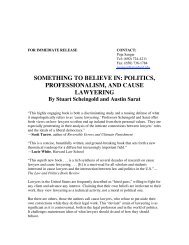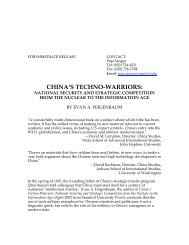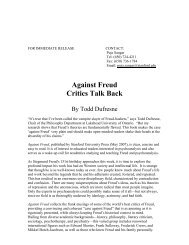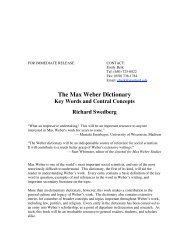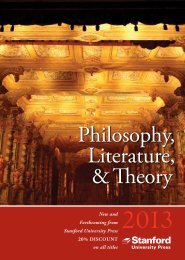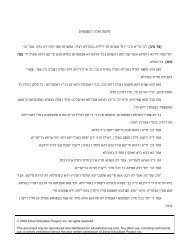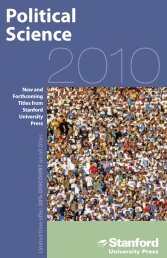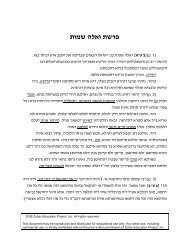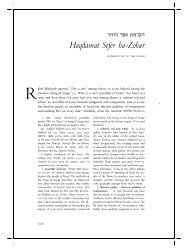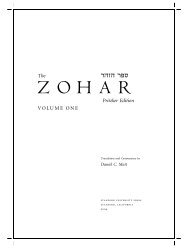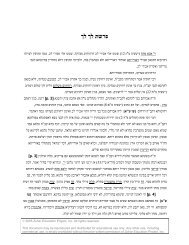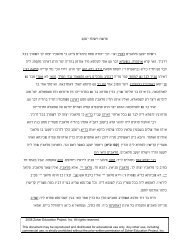THE ZOHAR: PRITZKER EDITION - Stanford University Press
THE ZOHAR: PRITZKER EDITION - Stanford University Press
THE ZOHAR: PRITZKER EDITION - Stanford University Press
You also want an ePaper? Increase the reach of your titles
YUMPU automatically turns print PDFs into web optimized ePapers that Google loves.
<strong>Stanford</strong><br />
FOR IMMEDIATE RELEASE<br />
publicity department<br />
1450 Page Mill Road, Palo Alto, California 94306-1124 Telephone 650-725-0823 Telefax 650-736-1784<br />
Contacts:<br />
Selma Shapiro 212-867-7038 selshapiro@aol.com<br />
Meryl Zegarek 917-493-3601 mz@mzpr.com<br />
“Through the centuries, the potency of the Zohar’s language has mesmerized even those who<br />
could not plumb its secrets. While Kabbalists delved deeply, the uninitiated chanted the lyrical<br />
Aramaic, often unaware of its literal meaning. In the words of an eighteenth-century mystic,<br />
‘Even if one does not understand, the language is suited to the soul.’”<br />
—Daniel C. Matt, from his introduction to <strong>THE</strong> <strong>ZOHAR</strong>: <strong>PRITZKER</strong> <strong>EDITION</strong><br />
STANFORD UNIVERSITY PRESS AND <strong>ZOHAR</strong> EDUCATION PROJECT, INC.<br />
ARE PROUD TO ANNOUNCE <strong>THE</strong> PUBLICATION OF<br />
the authoritative new English translation of<br />
the masterpiece of the Jewish mystical tradition<br />
<strong>THE</strong> <strong>ZOHAR</strong>: <strong>PRITZKER</strong> <strong>EDITION</strong><br />
Translation and Commentary by Daniel C. Matt<br />
TO BE PUBLISHED IN 12 VOLUMES<br />
Based on a newly constructed critical text—the only modern text that<br />
draws on many variants in the early Aramaic manuscripts<br />
AT LONG LAST, LAY READERS, SPIRITUAL SEEKERS, SCHOLARS,<br />
AND <strong>THE</strong> JEWISH COMMUNITY CAN PLUMB <strong>THE</strong> SYMBOLISM<br />
AND SECRETS OF THIS CLASSIC, CANONICAL WORK OF KABBALAH,<br />
A HIDDEN TREASURE OF WESTERN CULTURE
Ever since it emerged mysteriously in Castile, Spain toward the end of the 13th century, the Zohar has<br />
enthralled, confounded, challenged, and enraptured readers. Composed mostly in lyrical Aramaic, the Zohar<br />
is a mosaic of Bible, medieval homily, spiritual fantasy, and imaginative commentary, or midrash, on the Torah<br />
written in the form of a mystical novel. In it a group of rabbis wander through the hills of Galilee, discovering<br />
and sharing secrets of Torah: at times they interpret the actions of biblical figures, and at other times, they take<br />
center stage themselves through their adventures on the road and their encounters with various astonishing<br />
characters. The scope of the Zohar is far greater than a single book; it is virtually an entire body of literature,<br />
whose central theme is the intimacy between human beings and God. In this lies one of the Zohar’s boldest<br />
propositions, the capacity of the human being to effect change in the divine realm. Awestruck by the profundity<br />
of its insights, symbolism, and dreamlike images, Jews in many lands over the centuries have come to<br />
accept the Zohar as revealed truth—no less sacred than the two other major texts of their religion, the Torah<br />
and the Talmud. And yet, until now, there has never been a fully reliable comprehensive, scholarly English<br />
translation of this revered work with line-by-line commentary.<br />
In a monumental undertaking that has already stirred enormous interest and eager anticipation among<br />
scholars and various religious communities, Daniel C. Matt, one of the world’s foremost authorities on Jewish<br />
mysticism, spent the past four years in Jerusalem completing the first phase of this immense project: a 12volume,<br />
annotated English translation of the Zohar. The first two volumes of <strong>THE</strong> <strong>ZOHAR</strong>: <strong>PRITZKER</strong><br />
<strong>EDITION</strong> are set to appear from <strong>Stanford</strong> <strong>University</strong> <strong>Press</strong> on November 7, 2003, with a new volume scheduled<br />
to appear approximately every year.<br />
Volume I includes the Zohar’s very own introduction to the work and its explication of the stories<br />
of Creation and Noah’s Ark in Genesis. In this volume there will also be an Introduction by worldrenowned<br />
authority on Jewish thought and mysticism, Arthur Green, that traces the development<br />
of Kabbalah and the historical and literary significance of the Zohar; and a Translator’s Introduction<br />
by Daniel C. Matt that describes how he was able to establish the Aramaic text and offers suggestions<br />
on “How to Read the Zohar.”<br />
Volume II consists of the next five portions of Genesis, as the wandering rabbis of the Zohar continue<br />
their travels throughout Galilee, sharing their insights into the Torah (extending through<br />
Genesis 32:3)— coming upon wisdom at times in the most astonishing ways from a colorful cast of<br />
characters they meet on the road.<br />
Translating this keystone of Kabbalah presented enormous challenges. Not only was there no complete,<br />
reliable manuscript of the Zohar in the original Aramaic in existence anywhere in the world, but in all likelihood,<br />
none ever existed. Though the precise history of the Zohar is still shrouded in mystery, it originally circulated<br />
in fragments as a series of pamphlets or notebooks. Moses ben Shem Tov de Leon is thought to be the<br />
main creative force behind the Zohar—writing much of it himself, perhaps parts in collaboration with other
Kabbalists. No complete Zohar existed until the middle of the 16th century, nearly 300 years later, when the<br />
booklets were gathered and printed as a single work in Italy. Unfortunately the editors of the printed versions<br />
of the Zohar often rejected or revised original readings in the earlier handwritten manuscripts.<br />
To prepare his translation, Daniel Matt had to pour over surviving Aramaic manuscripts and compare<br />
variant readings, seeking to restore both the content and lyrical flavor of the original, scraping away centuries<br />
of scribal errors and editorial doctoring of the text. Working from the critical Aramaic text that he reconstructed,<br />
Daniel Matt has produced the most authoritative translation we have ever had of the Zohar—a literal<br />
yet poetic rendering that is worthy of this mystical masterpiece.<br />
Features that distinguish <strong>THE</strong> <strong>ZOHAR</strong>: <strong>PRITZKER</strong> <strong>EDITION</strong> from all other editions:<br />
• It is the first translation into English of the Zohar by a recognized academic scholar.<br />
• It is the only English edition that goes directly to the source—unearthing many of the major surviving<br />
manuscripts in the original language. Working with these, Daniel Matt was able to produce, in<br />
addition to the translation and commentary, the first modern critical, authoritative Aramaic text of<br />
the Zohar.<br />
• It restores the sacred passion of the original, much of which was censored out of the genteel prose<br />
of the old English translation. A luxuriant garden of holy eros, the Zohar overflows with love<br />
between the souls of Israel and Shekhinah (God’s lovely bride), and especially between the male and<br />
female aspects of God.<br />
• It is faithful to the literal content of the Zohar yet true to the lush imagery and colorful poetic voice<br />
of the original.<br />
• It provides a running commentary on the same page with the text that makes the mysteries of the<br />
Zohar accessible to the reader. The old English translation—composed in the 1930s—offers no<br />
running commentary, leaving the reader without any help in penetrating the Zohar’s unique terminology,<br />
multiple meanings, cryptic connotations, and esoteric symbolism.<br />
• It corrects misunderstandings of the text — restoring terms and even entire sections that were<br />
omitted from the old English translation because they were unfamiliar or difficult.<br />
In the Zohar the text of the Bible is the starting point, a springboard for the imagination. Daniel Matt<br />
notes that, in composing his commentary for <strong>THE</strong> <strong>ZOHAR</strong>: <strong>PRITZKER</strong> <strong>EDITION</strong>, he sought to elicit the<br />
meaning of the original without sacrificing its subtlety and ambiguity. “Remember that the Zohar was not<br />
intended to be easily understood, but rather to be deciphered. I want to inspire and compel the reader to struggle<br />
a little, to engage the text.”<br />
Daniel Matt encourages the reader of the Zohar to be open to new ways of thinking and imagining. He<br />
points to the Zohar’s reading of the opening words of the Torah, traditionally rendered: In the beginning God<br />
created, but interpreted in the Zohar as: With beginning, It (Divine Infinity) created God.
“We all assume that the verse describes the creation of the world, but for the Zohar it alludes to<br />
something even more primal: the emanation of the sefirot (aspects of divine personality) from Ein<br />
Sof (Divine Infinity). God, it turns out, is the object of the verse, not the subject! The ultimate<br />
divine reality, Ein Sof, transcends and explodes our comfortable conception of ‘God.’ The Zohar<br />
transforms the familiar story of Creation into divine biography.”<br />
The early years of the new millennium have seen a significant revival of interest in the Kabbalah and the Zohar,<br />
not only within Judaism but beyond it. Publication of <strong>THE</strong> <strong>ZOHAR</strong>: <strong>PRITZKER</strong> <strong>EDITION</strong> restores this<br />
great work to the Jewish people and to all people. Says Geoffrey Burn, Director of <strong>Stanford</strong> <strong>University</strong> <strong>Press</strong>,<br />
“<strong>Stanford</strong> is proud to be making a work of such literary and canonical significance available to scholars and<br />
spiritual inquirers of all traditions. The visionary force behind this project is Margot Pritzker, chair of Zohar<br />
Educational Project, Inc. (ZEPI), an organization devoted to the development of this translation and its dissemination<br />
throughout the world. The collaboration between ZEPI and <strong>Stanford</strong> <strong>University</strong> <strong>Press</strong> is based on<br />
a shared understanding of the importance of this work, and a shared sensitivity to its place in the tradition of<br />
great spiritual writing.”<br />
To anyone seeking to explore spirituality, the Bible, and the intimate connection between humans and<br />
the Divine, these books offer a limitless source of ecstatic devotion — and a glorious adventure. Daniel Matt<br />
writes: “As you undertake this adventure, expect to be surprised, stay alert. The Zohar’s teachings are profound<br />
and intense. Follow the words to what lies beyond and within; open the gates of imagination.”<br />
About Daniel C. Matt<br />
# # #<br />
<strong>THE</strong> <strong>ZOHAR</strong>: <strong>PRITZKER</strong> <strong>EDITION</strong><br />
Translation and Commentary by Daniel C. Matt<br />
Volume One: November 7, 2003 - 536 pages - $45.00 - ISBN 0-8047-4747-4<br />
Volume Two: December 4, 2003 - 496 pages - $45.00 - IBSN: 0-8047-4868-3<br />
FUR<strong>THE</strong>R INFORMATION, SAMPLE TEXT, PHOTOS & JACKET ART AVAILABLE AT<br />
WWW.SUP.ORG/<strong>ZOHAR</strong><br />
Daniel C. Matt, translator of <strong>THE</strong> <strong>ZOHAR</strong>: <strong>PRITZKER</strong> <strong>EDITION</strong>, is a leading authority on Jewish mysticism.<br />
For over twenty years he served as Professor of Jewish Spirituality at the Graduate Theological Union in<br />
Berkeley, California. He has also taught at <strong>Stanford</strong> <strong>University</strong> and the Hebrew <strong>University</strong> of Jerusalem. He has<br />
published six books, including: Zohar: The Book of Enlightenment; Zohar: Annotated and Explained; The<br />
Essential Kabbalah; and God and the Big Bang: Discovering Harmony between Science and Spirituality. He has<br />
spent the past four years in Jerusalem working on this translation and currently lives in Berkeley, California.
About Arthur Green<br />
Arthur Green, who supplied the Introduction on the Kabbalah and the literary and historical significance of<br />
the Zohar, is a leading Judaic scholar and author, and co-chair of the Academic Committee for the Translation<br />
of the Zohar. Dr. Green, the Philip W. Lown Professor of Jewish Thought at Brandeis <strong>University</strong>, has written<br />
several books and many articles on mysticism, Hasidism, Jewish spirituality, and contemporary theology. He<br />
lives in Newton Centre, Massachusetts.<br />
About Margot Pritzker<br />
Mrs. Thomas (Margot) Pritzker chairs <strong>THE</strong> <strong>ZOHAR</strong>: <strong>PRITZKER</strong> <strong>EDITION</strong> project. Convinced by her studies<br />
in Bible and Rabbinic literature of the need for a scholarly English language edition of the Zohar, Mrs.<br />
Pritzker worked with the Pritzker Family Philanthropic Fund to undertake the development of this translation,<br />
and to assist in its dissemination throughout the world. She has a B.A. in Art History from Northwestern<br />
<strong>University</strong>, and an M.A. from the <strong>University</strong> of Chicago in Judaic Studies. She begins work this fall towards<br />
her doctorate in Bible at the <strong>University</strong> of Chicago.<br />
About <strong>Stanford</strong> <strong>University</strong> <strong>Press</strong><br />
Over the last 75 years, <strong>Stanford</strong> <strong>University</strong> <strong>Press</strong> has established a reputation as one of the nation’s leading publishers<br />
of academic books in the humanities and the social sciences. The <strong>Stanford</strong> <strong>University</strong> <strong>Press</strong> list has won<br />
numerous awards and is highly respected throughout the scholarly community as a valuable source of new<br />
knowledge, pioneering inquiry, and innovative theories. Over the last decade, the <strong>Press</strong> has emerged as a leading<br />
English language publisher of Jewish studies. <strong>Stanford</strong> is committed to the continuation of this long tradition<br />
of service to scholars, and to the perpetuation of the <strong>Stanford</strong> <strong>University</strong> <strong>Press</strong> imprint as a benchmark of<br />
intellectual excellence.



